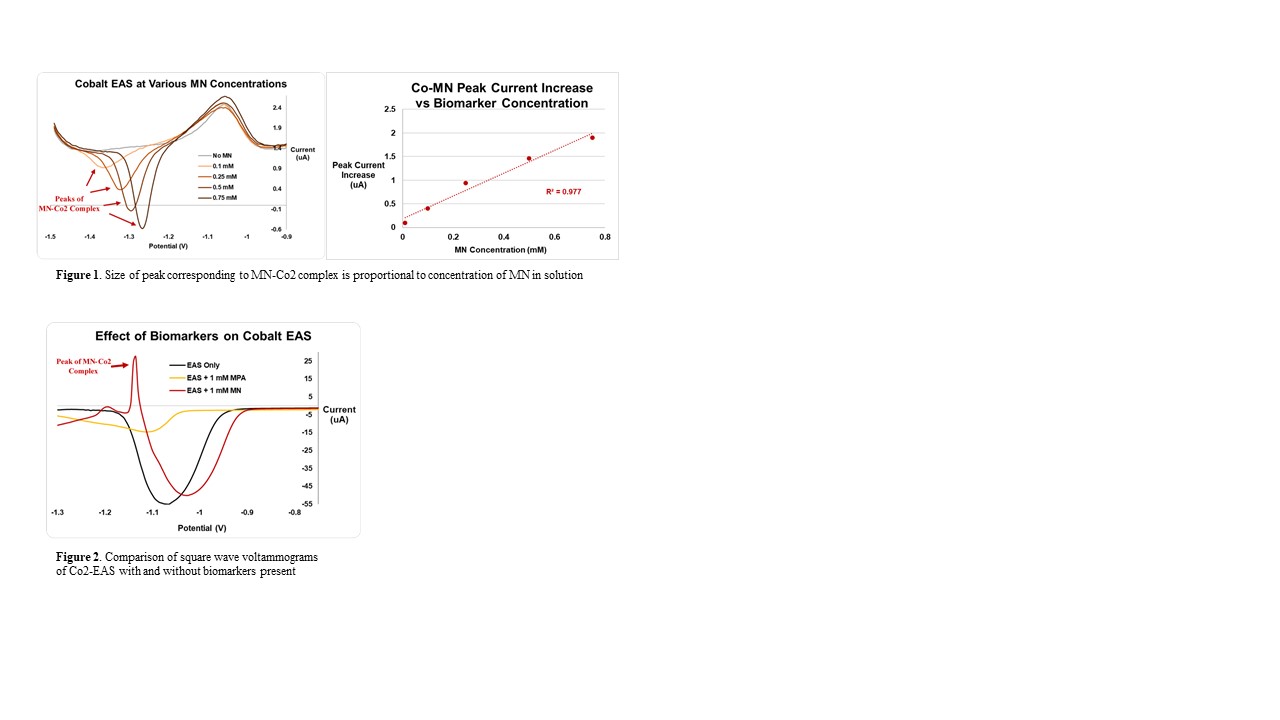2020 Virtual AIChE Annual Meeting
(523g) Rapid Detection of Tuberculosis Breath Biomarkers Using Engineered Electroactive Solutions (EAS)
Authors
Previously, our lab developed a sensing platform utilizing Engineered Electroactive Solutions (EAS) on inexpensive, commercially available screen-printed electrodes, in which the change in a transition metal of known electrochemical activity is observed when exposed to an analyte of interest [2]. The original study was successful in using a divalent copper electroactive solution (Cu2-EAS) to detect MN down to 1 mM using cyclic and square wave voltammetry techniques (CV and SWV, respectively). However, the relatively high reactivity of copper may limit specificity. The sensing platform has been improved to use a divalent cobalt electroactive solution (Co2-EAS), with a limit of detection of about 0.01 mM of MN, about 100x more sensitive than Cu2-EAS. When Co2-EAS is mixed with a sample solution of MN, a peak specific to the metal-biomarker complex is present in both the forward and reverse scans, the height of which corresponds to the amount of biomarker present (see figure 1). The addition of this peak leads to a more sensitive and specific test for MN than the Cu2-EAS, The Cu2-EAS utilized a âfingerprintâ method in which the relative heights of copperâs existing redox peaks were compared. Unlike the Cu2-EAS, the Co2-EAS is also able to identify MPA in solution by a significant change in the existing cobalt peaks when it is added to solution, as shown in figure 2.
The simple sample collection and testing methods for an EAS based sensor is ideal for resource limited communities where TB is prevalent. The ability to perform sample collection and testing remotely as well as store collected breath samples for later testing provides flexibility to both patients and technicians. Disposable testing kits can be assembled for less than $5 per test, meeting the goal price point for TB triage testing put forth by Vanât Hoog et al, estimating a 42% reduction in cost compared to âXpert for allâ testing in Uganda [3]. Field testing of this novel sensing platform will be conducted in collaboration with Makerere University in Kampala, Uganda to determine sensor performance and to better understand patient needs at the point of care.
References:
[1] World Health Organization, âStatus of the TB epidemic,â 2019.
[2] Willis C, Misra M, Mohanty S, 2019, âEngineered Electroactive Solutions for Electrochemical Detection of Volatile Organic Biomarkers Associated with Disease,â 235thECS Meeting, Dallas TX, 26-30 May
[3] A. H. vanât Hoog et al., âOptimal Triage Test Characteristics to Improve the Cost-Effectiveness of the Xpert MTB/RIF Assay for TB Diagnosis: A Decision Analysis,â PLoS One, vol. 8, no. 12, p. e82786, Dec. 2013.
